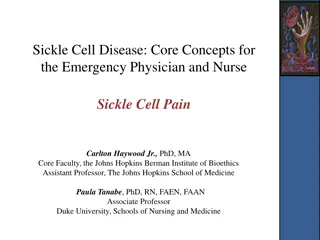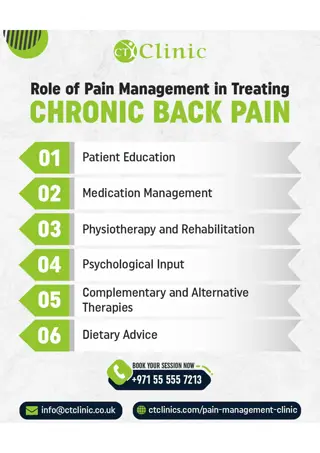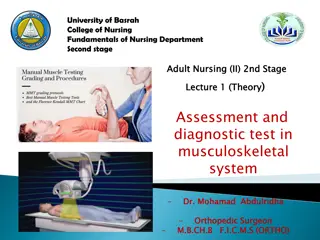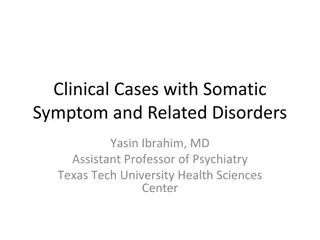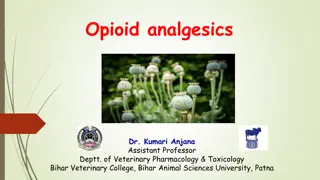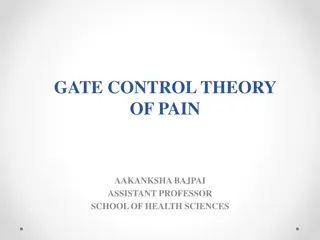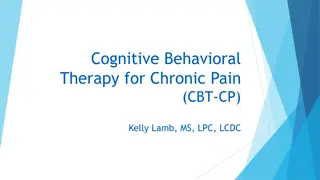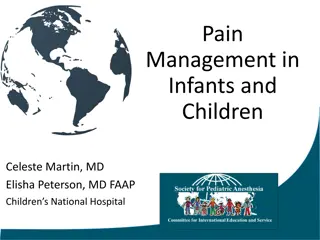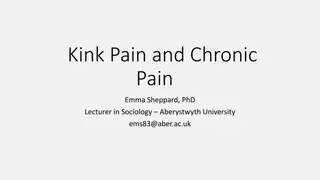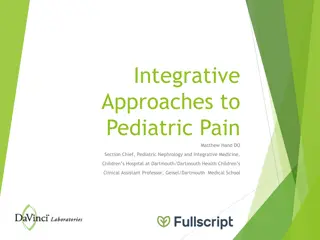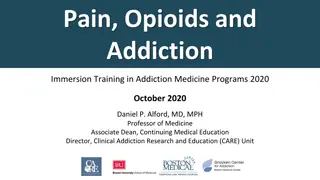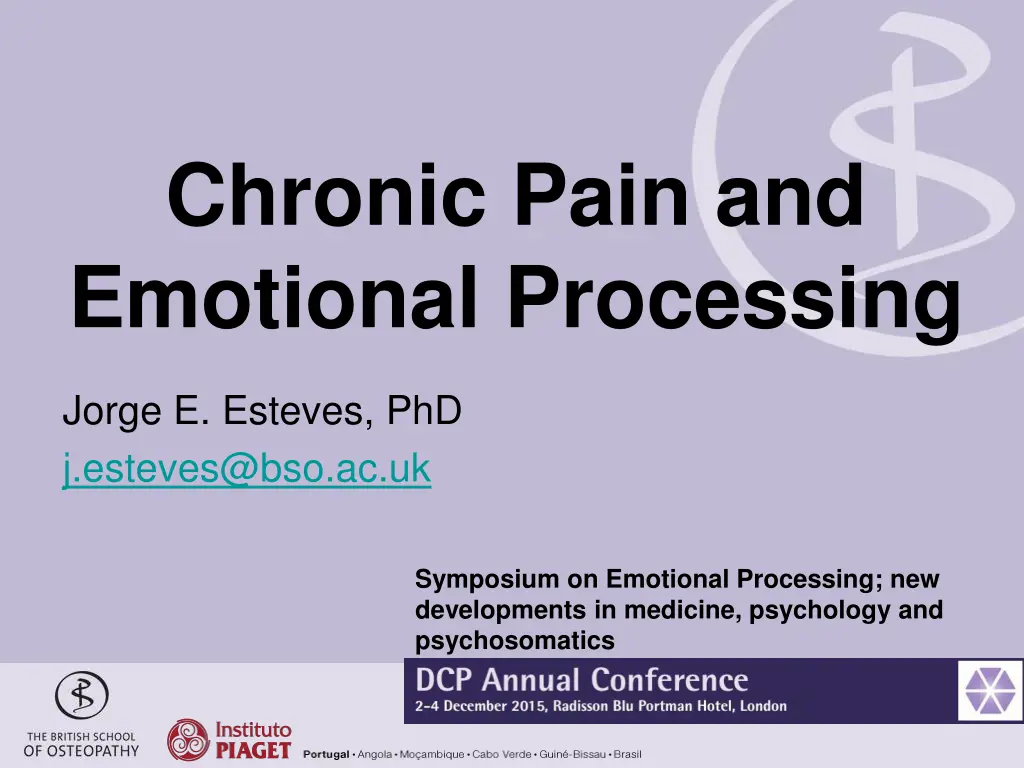
Emotional Processing in Chronic Pain Patients
Explore the relationship between chronic low back pain and emotional processing in patients through a case-control study. Findings reveal higher emotional processing scores in chronic pain individuals. This research sheds light on the emotional aspects of chronic pain conditions, providing valuable insights for treatment and management strategies.
Download Presentation

Please find below an Image/Link to download the presentation.
The content on the website is provided AS IS for your information and personal use only. It may not be sold, licensed, or shared on other websites without obtaining consent from the author. If you encounter any issues during the download, it is possible that the publisher has removed the file from their server.
You are allowed to download the files provided on this website for personal or commercial use, subject to the condition that they are used lawfully. All files are the property of their respective owners.
The content on the website is provided AS IS for your information and personal use only. It may not be sold, licensed, or shared on other websites without obtaining consent from the author.
E N D
Presentation Transcript
Chronic Pain and Emotional Processing Jorge E. Esteves, PhD j.esteves@bso.ac.uk Symposium on Emotional Processing; new developments in medicine, psychology and psychosomatics
Introduction Chronic pain is a complex and poorly understood condition incorporating sensory, cognitive and emotional elements. Research demonstrates a strong association between chronic pain states such as chronic low back pain and psychological factors such as anxiety, fear-avoidance, self-efficacy, catastrophizing and depression (e.g., Pincus et al., 2002; Carson et al., 2007; Costa et al., 2011). Until recently, the way in which chronic back pain sufferers process their emotions was largely unknown. We conducted two case-control studies using a between- groups correlational design to investigate the relationship between various chronic pain states and emotional processing.
Research Aim study 1 To examine the way in which patients with CLBP process their emotions compared to a group of individuals without a history of CLBP. Suppression Unprocessed Emotion Impoverished Emotional Processing If a relationship exists, establish whether this applies equally to all facets of emotional processing. Unregulated Emotion Avoidance Baker, R., Thomas, S., Thomas, P.W., Owens, M. (2007) Development of an Emotional Processing Scale. Journal of Psychosomatic Research, 62, 167 178.
Dimensions of the Emotional Processing Scale (EPS-25) Detached experience of emotions. Poor emotional insight. Potential to somatise emotional experience. Excess control of emotions and expression. Suppression Unprocessed Emotion Intrusive & persistent emotional experiences. Impoverished Emotional Processing Avoidance of negative emotional triggers. Unregulated Emotion Avoidance Inability to control ones emotion.
Method Study 1 Design: Case-control study Two participant groups: Control Group (N=55) Chronic Lower Back Pain (CLBP) Group (N=55) Participants voluntarily completed the EPS-25 A 25 item statistically valid and reliable questionnaire (p<0.01) (Baker et al, 2007) 5 core emotional processes Participants also completed a biographical questionnaire All participants: age, gender, ethnic origin, etc. CLBP participants: duration, frequency and other sources of pain
Results Study 1 CLBP patients scored significantly higher in the overall EPS-25 score [p = 0.00, d = 0.71, effect size = 0.33] A post hoc power analysis revealed that the statistical power for this study was 0.96 for detecting a moderate to large effect size.
Results Study 1 Also significant differences in four factors: suppression (p = 0.00, effect size = 0.44) unprocessed emotion (p = 0.02, effect size = 0.23) unregulated emotion (p = 0.02, effect size = 0.22) impoverished emotional experience (p = 0.04, effect size = 0.20)
Preliminary discussion Preliminary evidence of a link between CLBP and altered emotional processing, suggesting that those with CLBP may be generally less able to process their emotions effectively. Higher EPS-25 scores indicate relatively dysfunctional emotional processing (e.g., Baker et al., 2007). Our results suggest that CLBP sufferers are more likely to be ill-equipped to process their emotions than pain-free individuals. An impaired ability to effectively assimilate upsetting emotional episodes prolongs their effects and disrupts subsequent experiences and behaviours (Rachman, 1980).
Research Aim study 2 To examine the way in which chronic pain sufferers process their emotions whilst also measuring for anxiety and depression to investigate their role in this putative relationship. Esteves, J.E. and Hicks, O. (in preparation)
Method study 2 Design: Case-control study Two participant groups: Control Group (N=27) Chronic Pain (CP) Group (N=32) Participants voluntarily completed EPS-25 Patient Health Questionnaire for Depression - (PHQ-9) General Anxiety Disorder questionnaire - (GAD-7) Chronic Pain Form (troublesomeness grid Parson et al (2006) It incorporates a scale for each of the thirteen different body regions Participants also completed a biographical questionnaire All participants: age, gender, ethnic origin, etc. CP participants: duration, frequency & other sources of pain
Results EPS-25 Chronic pain patients scored significantly higher in the overall EPS- 25 score with a moderate effect size [p=0.03, effect size=0.38]
Results EPS-25 Also significant differences in all five factors: suppression [p = 0.01, effect size = 0.32] unprocessed emotion [p = 0.01, effect size = 0.33] unregulated emotion [p = 0.03, effect size = 0.29] avoidance [p = 0.005, effect size = 0.36] impoverished emotional experience [p = 0.02, effect size = 0.30]
Results Anxiety and Depression CP patients scored significantly higher in GAD-7 scores with a medium effect size [p = 0.02,effect size=0.31] CP patients scored significantly higher in PHQ-9 scores with a medium effect size [p = 0.003,effect size=0.39]
Conclusion Dysfunctional emotional processing and regulation is associated with chronic pain, particularly low back pain; anxiety and depression may potentially play a role in this relationship. Our observed associations alone do not allow for causal inferences to be made and the question of whether dysfunctional emotional processing is a consequence or a determinant of chronic pain is as yet not established. However, evidence from neuroimaging prospective studies show that the transition from acute to chronic shows change from acute pain circuitry to emotional/reward circuit and this occurs within the first year. Hashmi, J. A., et al. (2013). Shape shifting pain: chronification of back pain shifts brain representation from nociceptive to emotional circuits. Brain, 136(9), 2751-2768.
Implications for manual therapy Collaborate with other specialist practitioners - improved emotional processing has been shown to be highly successful in reducing emotional distress (Whelton, 2004). The sensory landscape of the physical body provides a point of entry into the emotional domain/reward system. Manual therapy may affect the emotional domain through the use of techniques aimed at reducing sympathetic outflow, anxiety and depressive feelings (Lindgren et al., 2010). Alongside manual therapy, mindfulness-based approaches are likely to play an important role in regulating emotional processing in CP patients.
Acknowledgments Professor Roger Baker and his team at Bournemouth University Hilary Abbey, Mike Ford, Laura Wheatley, Oliver Hicks, Elaine Mathias, Yvonne Kirchner and Rachael Rollins at the British School of Osteopathy Clare Mayall, Jill Green, Sam McInerney and Eva Winter at Oxford Brookes University


